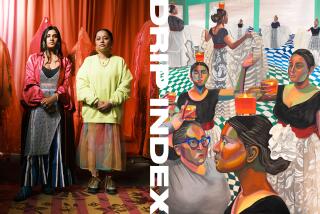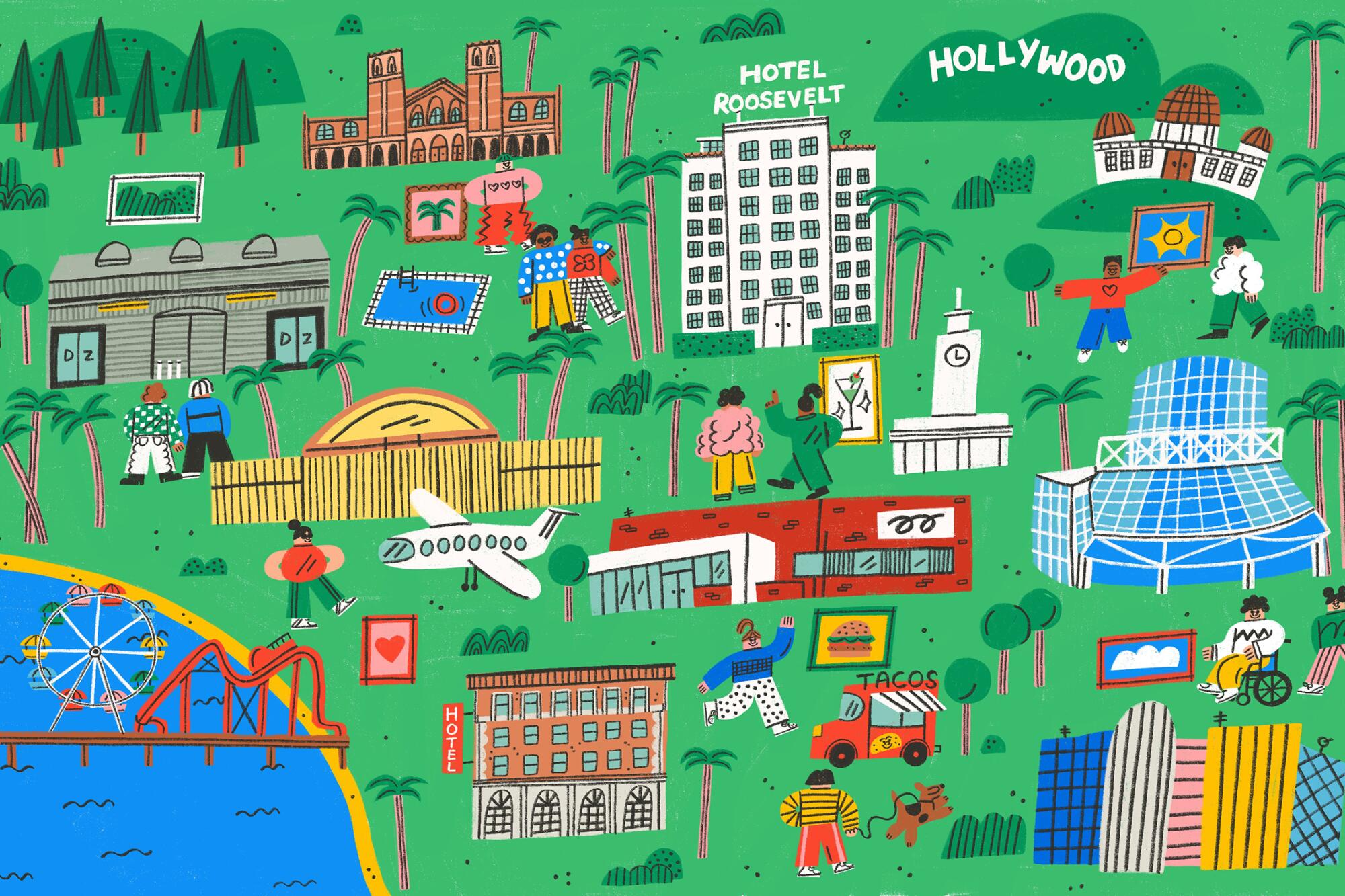
Ready your comfiest shoes, flounciest outfits and edgiest eyewear — it’s art fair season.
Last spring, L.A.’s art fairs marched forward despite Omicron surges, an uncertain public and COVID precautions that, for many fairs, included limiting capacity. Fair dates were more staggered as well, with the L.A. Art Show opening in mid-January and three additional art fairs — Frieze Los Angeles, Felix LA and Spring/Break Art Show LA — running during what’s now referred to as Frieze Week in mid-February. This year, the fairs return in full force — and all at once. The 2023 season will be bigger than ever with more international participants, full visitor capacity and one new fair added to the mix. Five art fairs will run concurrently starting Feb. 15.
So what’s back, what’s new and where to start?
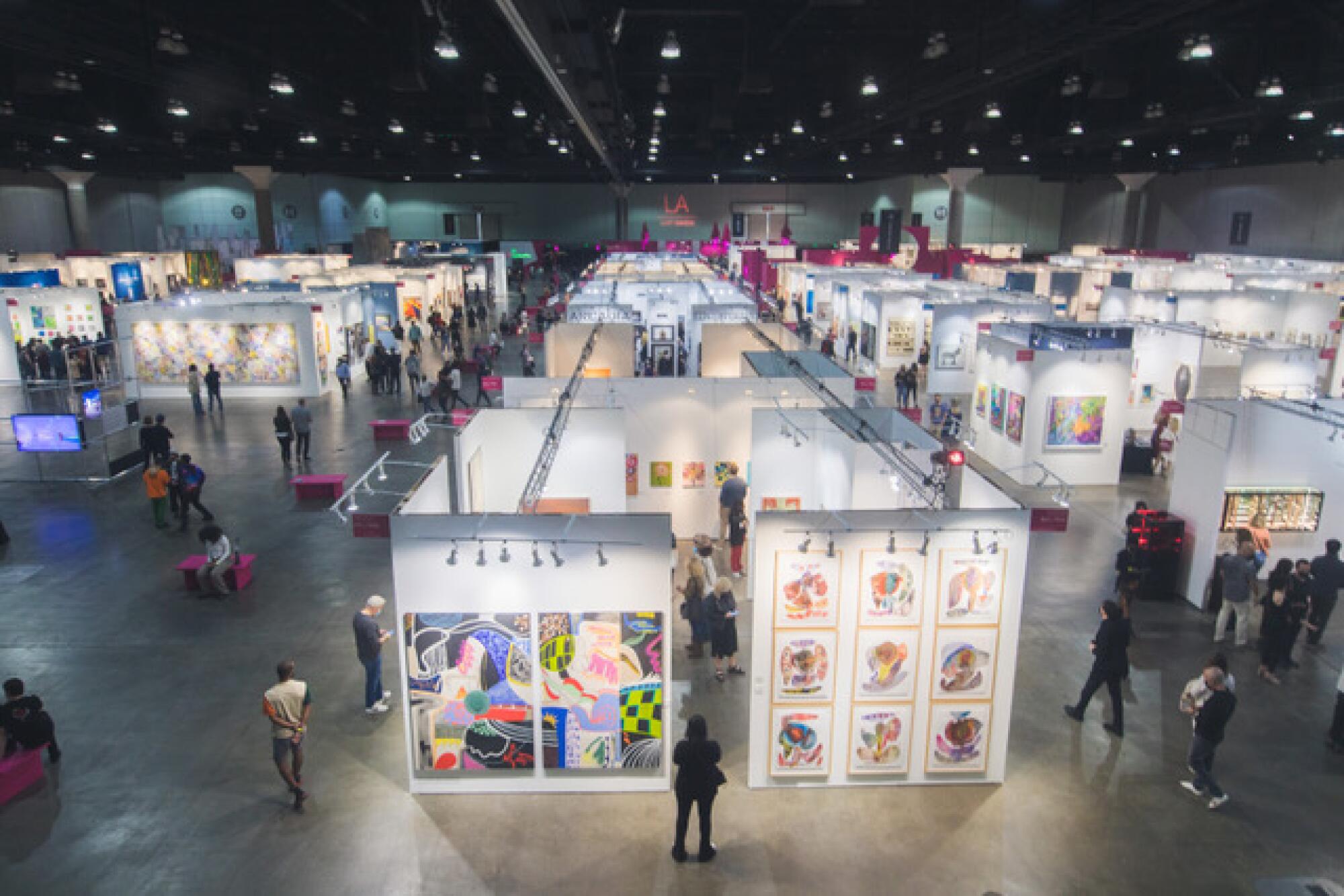
L.A.’s longest-running art fair returns
The 28th edition of the L.A. Art Show — the city’s longest-running art fair — will be held in the Los Angeles Convention Center’s West Hall from Feb. 15 to 19. The fair pushed its run dates forward for 2023 to coincide with Frieze Week. Frieze, a heavy hitter in the art fair world, debuted in L.A. in 2019 and brings with it an influx of global galleries, artists and collectors. Art happenings beget art happenings as events coalesce, and the L.A. Art Show wanted to take advantage of the moment.
“We thought it’d be beneficial for collectors and galleries and attendees — for everyone — to have a [coordinated] art event, to go to multiple shows,” LAAS director and producer Kassandra Voyagis says. “We confirmed the dates for 2024 as well.”
The LAAS will be larger this year than last, with more than 120 participating galleries from around the country and internationally, compared with 70 last year, all showing modern and contemporary art. It will also feature a larger “global presence,” Voyagis says. In addition to its European Pavilion, the fair is debuting a Japanese pavilion, featuring six galleries, and it will be showing more South Korean galleries than in the past, 14 in all.
“It’s been a tough couple of years everywhere, for everyone,” Voyagis says. “But it’s easier to travel now than the previous two years and I wanted a more international component. And we have such a large Korean community in L.A.”
The fair’s long-running DIVERSEartLA, a noncommercial section curated by Marisa Caichiolo, is a point of differentiation for the LAAS, Voyagis says. This year, it will feature nine local and international art institutions and nonprofits addressing the global climate crisis through multimedia presentations and immersive experiences. The Museum of Latin American Art, for example, will present L.A. “eco-feminist” artist Judy Baca’s three panel, double-sided mural “Matriarchal Mural: When God Was a Woman, 1980-2021.” The Glendale Central Library’s ReflectSpace Gallery will present Korean Artist Han Ho’s apocalyptic-minded, nine-part multimedia installation, “Eternal Light,” inspired by Michelangelo’s “The Last Judgment.”
“It’s about education and museums and community engagement,” Voyagis says of DIVERSEartLA. “We give 25% of our platform, meaning space and build on the fair floor, to this programming and there’s no profit on our end.”
As to whether there are enough collectors to sustain five simultaneous art fairs in L.A., Voyagis points to Miami and Miami Beach, which host more than a dozen concurrent art fairs between them the first week of December. “It just creates excitement and more international travel and the possibility for collectors and attendees to have more shows to visit,” she says. “There’s diversification, so there’s choice.”
The L.A. Art Show, Los Angeles Convention Center, West Hall, downtown; Feb. 15–19; laartshow.com for info and tickets.
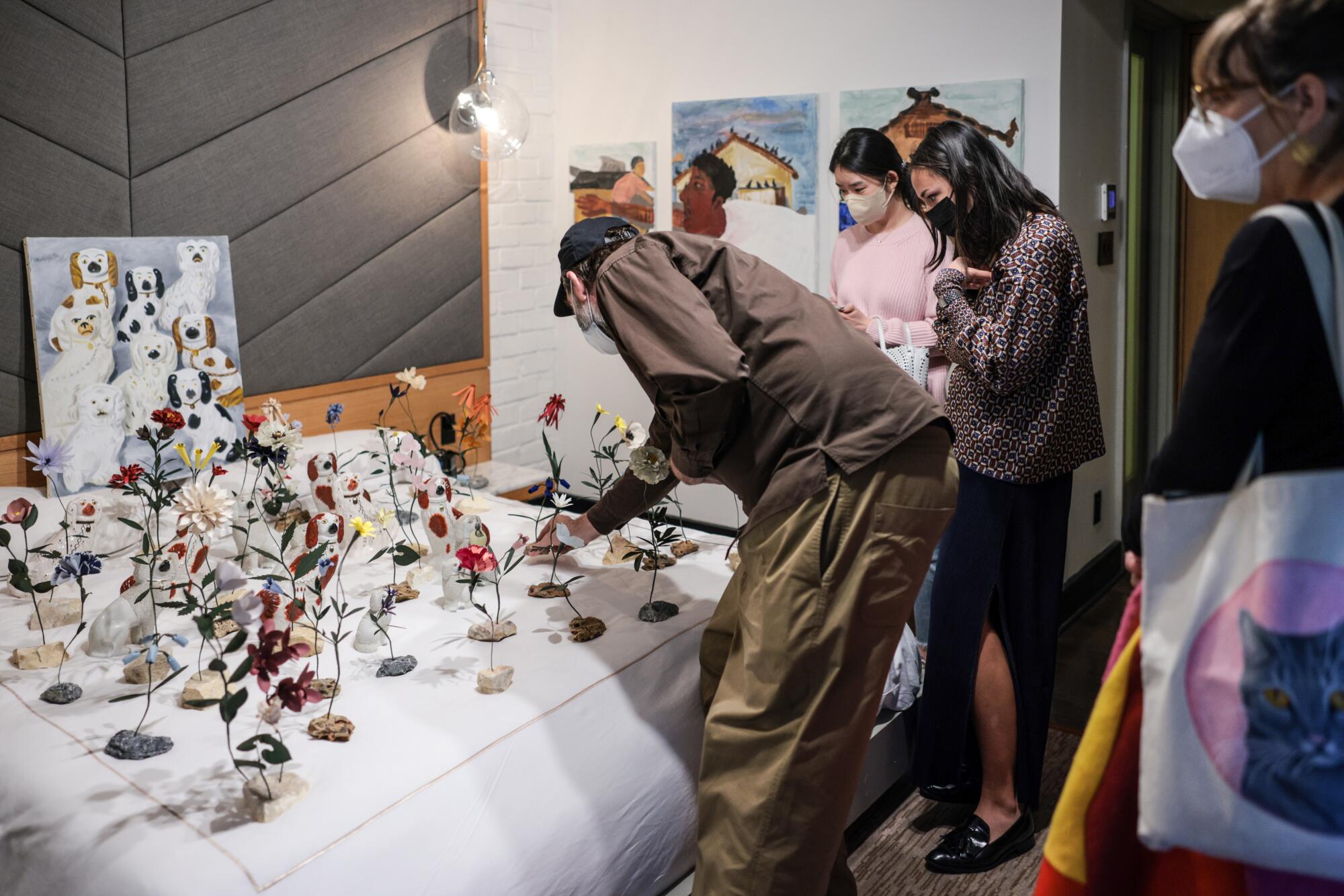
Felix LA rings in five years
Meanwhile, Felix LA is returning to the Hollywood Roosevelt Hotel from Feb. 15 to 19 for its fifth iteration. The contemporary art fair will again be situated in cabanas around the hotel’s palm tree-rimmed pool and in suites across two floors of the hotel.
The fair won’t be larger this year, per se, but it will be longer. It will open on Wednesday, one day earlier than last year — a decision made so as not to overlap with Frieze Los Angeles’ Thursday opening, fair co-founder Mills Morán says.
“[Frieze] is in Santa Monica and we didn’t want to bottleneck people driving back and forth on a VIP day, so we elected to space that out,” he says.
Felix LA 2023 will feature 65 international exhibitors, about 25% of which are new participants. The fair aims to provide the “anti-trade show experience,” Morán says — contemporary art shown in an intimate hotel setting amid a cool, relaxed vibe. “It’s a much different experience than walking into a trade show with a ticket and sort of being herded around, in big hallways, gallery after gallery after gallery. You can take a break and sit around the pool,” he says.
Highlights this year, Morán says, include artist-led projects such as Andrea Zittel’s High Desert Test Sites booth. It will exhibit ceramics and other objects from the Joshua Tree-based nonprofit. As well as a particularly meta showing by the New York-Based gallery A Hug From the Art World. It will display about 40 action figurines of famous artists by Jeffrey Dalessandro — think a Jeff Koons doll with a balloon dog or a David Hockney figurine perched near the hotel’s David Hockney-painted pool.
“It’s a poke at the art world, it’s a poke at celebrity. It’s really fun,” Morán says.
Moran isn’t worried about the five fairs cutting into one another’s attendance because the fairs are all distinct.
“People seek out parts of each fair that are more interesting to them,” he says. “If you’re more interested in photography, you’re gonna go to the photography fair. If you’re really zoned in on contemporary art, Frieze and Felix will have that covered. The L.A. Art Show might have more historical [modern art] presentations. I think there’s a little something for everybody.”
Felix LA, the Hollywood Roosevelt Hotel, Hollywood; Feb. 15-19; felixfair.com for info and tickets.
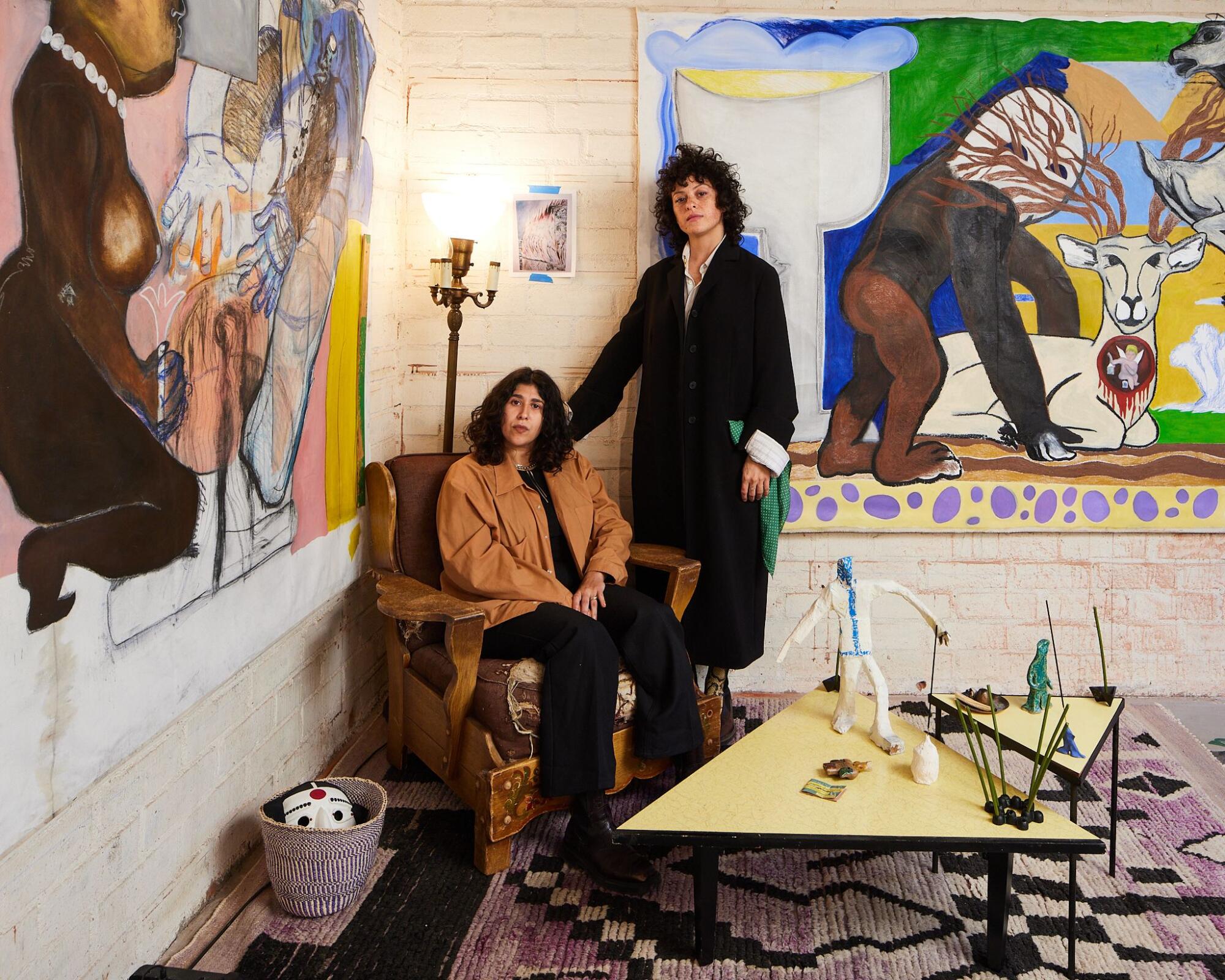
Spring/Break Art Show LA is taking place in unique locations
At Spring/Break Art Show LA, also opening Feb. 15, that distinction means showing contemporary art by emerging and midcareer artists in unique, historic or underused architectural locations. Last year it occupied a former 1940s munitions factory in Culver City, where it will again be housed this year, a venue now known as Skylight Culver City. It didn’t stage a 2021 fair due to COVID, but its 2020 fair filled 70,000 square feet of the industrial-looking Row DTLA. Its inaugural 2019 fair was in a former fruit and vegetable warehouse on the edge of the downtown L.A. Arts District.
“That juxtaposition of disparate elements is the key,” says fair co-founder and co-director Andrew Gori.
Spring/Break Art Show LA is a curator-led fair, organized around an annual theme, at which independent curators participate free in exchange for the fair taking a cut of sales. The model is meant to eliminate overhead and encourage experimentation. The theme creates a dialogue between works in the various booths. The fair plans to feature about 60 curated exhibitions — last year there were 50 — and it will be adding participants before it opens.
“We realized a lot of the people we would be showing wouldn’t be able to afford renting real estate at a fair, especially emerging artists and curators spending their own money to get those artists out there,” Gori says. “So we give independent curators free space and we run all sales through us and our online platform and we take 35%. That way we can encourage more groundbreaking, less commercial projects.”
Works at Spring/Break Art Show LA span mediums, including painting, sculpture, installations, photography, performance and multimedia. Last year’s theme was “Neo-medieval” — “a time of plague,” Gori says. This year, in response to a feeling of hope that we’re beyond COVID, or at least in a time of renewal, the theme is “Naked Lunch,” nodding to “Neo-Renaissance,” Gori says. The inspiration comes from the Manet painting “Le Déjeuner sur l’herbe” (“The Luncheon on the Grass”) depicting young bohemians enjoying a picnic outdoors, semi-clothed, “appreciating the body, the outdoors, bohemian pleasure — a far cry from the dark ages of the Neo-medieval show,” Gori says.
How does Spring/Break Art Show LA aim to compete with the bigger art fairs during such an active art moment in the city?
It doesn’t. Gori describes the fair as having a “symbiotic relationship.”
“We don’t feel in competition with the other fairs,” Gori says. “We feel like the little birds that nestle between the teeth of the larger hippos. We use the time that the larger fairs create — the moment — to fix a little bit of the light on emerging artists.”
Spring/Break Art Show LA, 5880 Adams Blvd., Culver City; Feb. 15-19; springbreakartshow.com for info and tickets.
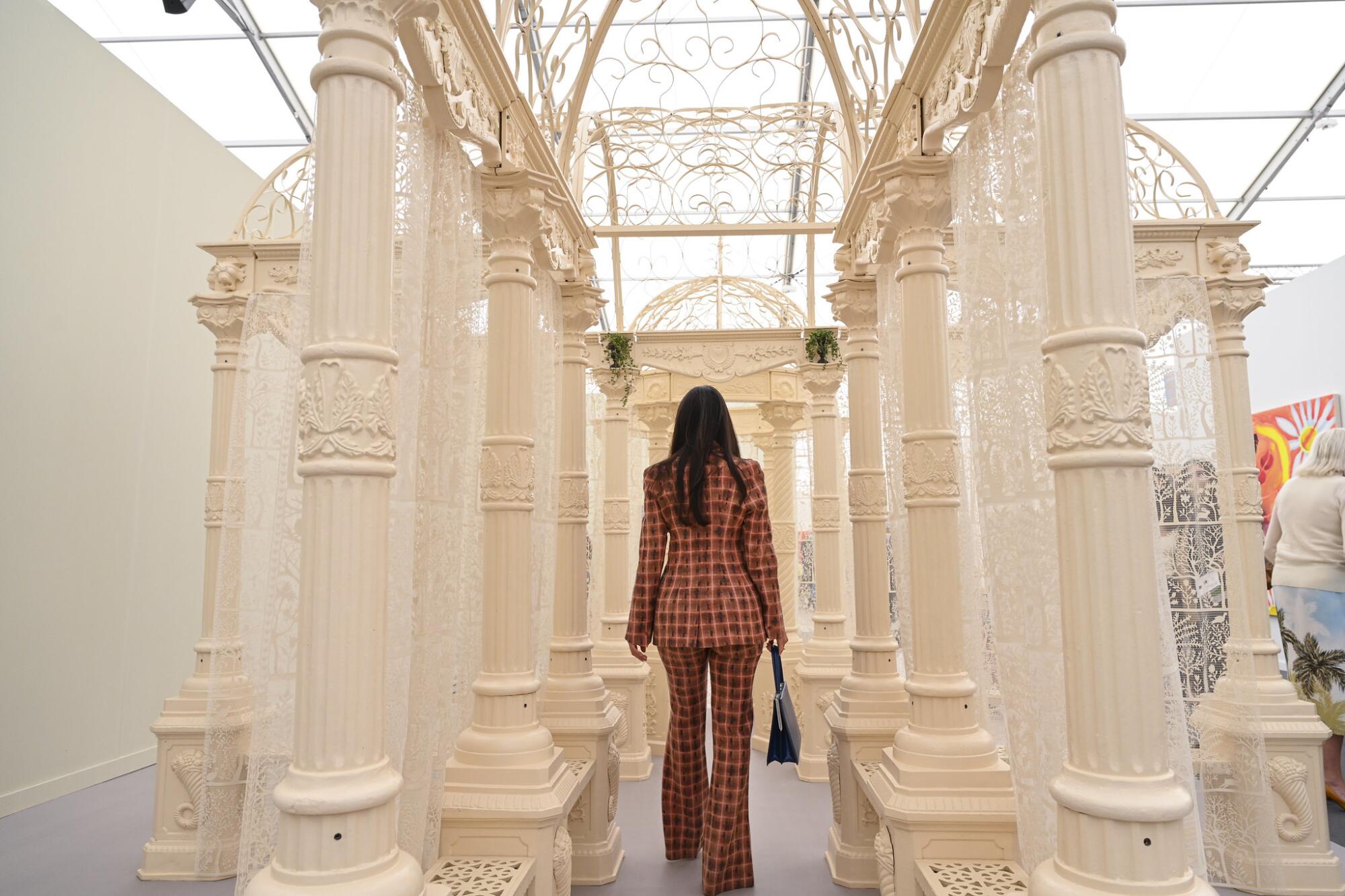
Frieze is taking over the Santa Monica Airport
If Spring/Break Art Show LA is the little bird, then Frieze Los Angeles would be the hippo. The fair, this year held at the Santa Monica Airport, will open for VIPs on Thursday morning, Feb. 16, and run through Sunday, Feb. 19. It’s the contemporary art fair’s biggest L.A. presentation to date, with more than 120 galleries representing 22 countries and a sprawling 30% larger exhibition space. That means work on view in both the exhibition tent, the airport’s Barker Hangar and outdoors around the airfield.
The fair limited attendee capacity last year through timed, staggered entry; this year it’s instituting the same ticketing system, but it’s back to full, pre-pandemic capacity. It expects to meet its pre-pandemic headcount of about 35,000 attendees over four days.
The fair will bring back its longstanding Frieze Projects, showing outdoor, site-specific installations and large-scale sculptures. The nonprofit Art Production Fund is curating the on-site works; Jay Ezra Nayssan, founding director of Del Vaz Projects, is curating an off-site series to be held at significant architectural sites around the city. And there will again be an area of the fair featuring artist-led and community-oriented nonprofits.
But this year’s iteration of the Focus section — featuring younger galleries and emerging artists — is particularly exciting, says Christine Messineo, director of Frieze Los Angeles and Frieze New York. Focus will not only be larger, but also wider in scope. It will feature 18 U.S. galleries that have been in operation for 12 years or less compared with 11 local galleries last year that had been in operation for 15 years or less. The presentation, in the Barker Hangar, is curated by the Walker Art Center’s Amanda Hunt, who previously was at the Lucas Museum of Narrative Art. So she brings both a local and national perspective and will work with associate curator Sonya Tamaddon.
“Since I’ve known Frieze, it’s always been this fair for discovery,” Messineo says. “And if you watch the trajectory of the galleries who have participated in our Focus section — Commonwealth and Council, Château Shatto, François Ghebaly, Night Gallery — they’re now sitting within the main fair. So that Focus section becomes a place for growth, like a seeder to the main fair. And as we continue to grow, it becomes even more crucial.”
Highlights of the Focus presentation, Messineo says, include two up-and-coming photographers: Clifford Prince King, who’s showing at Stars gallery — “he’s a queer Black photographer and he focuses on domestic intimate relationships, really beautiful portraits,” she says — and Mark McKnight at Park View/Paul Soto. “The most seductive gorgeous black-and-white silver gelatin prints I’ve ever seen in person,” she says of McKnight.
Messineo also notes presentations, in the main fair, by Rick Lowe at Gagosian, Bob Thompson at Michael Rosenfeld Gallery and Ming Smith at Nicola Vassell Gallery.
Regarding the citywide momentum Frieze has sparked, Messineo credits both Frieze’s global audience and L.A. itself.
“We bring global galleries, collectors coming from all over the world, institutional groups and trustees coming in from all over the world, and I think anyone would be excited to engage with that audience,” Messineo says. “But also, I think people really understand Los Angles as a center for art making and creativity.”
Frieze Los Angeles, the Santa Monica Airport, Santa Monica; Feb. 16-19; frieze.com for info and tickets.
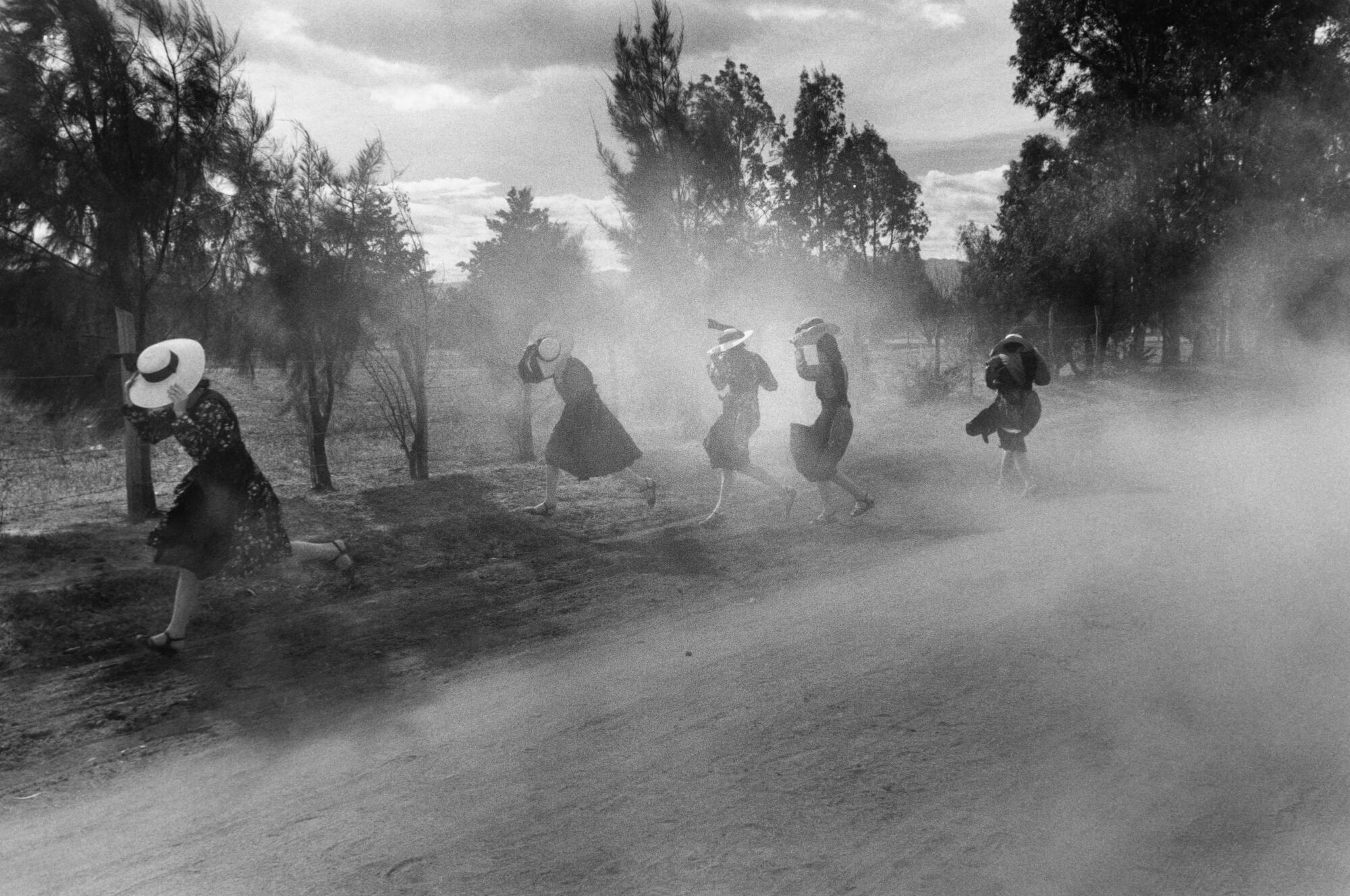
Photo Forward Los Angeles is debuting this year
Photo Forward Los Angeles is the new kid on the block, running Feb. 18-19 at Danziger Gallery in Bergamot Station Arts Center. The inaugural fair of the 10-year-old nonprofit Photographic Arts Council Los Angeles is especially intimate, with only a dozen exhibitors, mostly U.S. galleries with one from Canada, and two book publishers. But it aims to be as broad and inclusive as possible. It’s free to the public to attend.
The goals? To start conversations around photographic arts, shine a spotlight on galleries specializing in photography and hopefully sell some work.
“It’s part of the mission of PAC LA to support the field and encourage participation in the community and the arts ecosystem, says Paula Ely, PAC LA board president. “We thought this was an opportunity to expand our mission by creating a public space for collectors, artists, curators, writers and enthusiasts to gather during this arts weekend in Los Angeles. We’d like to make it a permanent feature; we’ll see how it goes.”
The other art fairs will show photography, but Photo Forward Los Angeles may be the best destination for young or new collectors. Works on view will range from vintage photographs dating back to the beginning of the medium in the mid-19th century to contemporary images by both emerging and well-known artists such as Robert Frank, Harry Callahan and Imogen Cunningham. The range of price points is unusually wide, Ely says, with “accessible” prices for newbie collectors and blue chip-level price tags for museum-represented artists.
Starting a photo fair is a “bold move,” Ely admits, especially considering the history of now-defunct photo fairs in L.A., including Paris Photo Los Angeles and Photo L.A., among others. But Ely notes that the nonprofit organization has a number of “experienced collectors on the board” who may draw galleries. “And we also purposefully started small,” she says. “We think there’s an appetite for the photo community to gather in this way and that they’ll support it.”
COVID-19 doesn’t seem to be a concern this year among fair organizers. Every fair director or representative interviewed for this story said they’d heed city and county health guidelines, but none are instituting any special COVID precautions beyond, in some cases, offering hand sanitizer. Individuals are encouraged to navigate the fairs as they feel most comfortable.
Rest up, because Frieze Week comes on the heels of another art fair the week before: Intersect Palm Springs, running Feb. 9 to 12 at the Palm Springs Convention Center.
The robust art fair scene, the LAAS’s Voyagis says, is yet another metric of art world growth in L.A.
“You see more galleries moving here and now you see it in the fairs,” she says. “It’s a sign of health in the art world, of L.A. becoming a city for art shows and for collectors to buy in. Now there’s a platform for other fairs to come in the future — it’s just going in that direction.”
Photo Forward Los Angeles, Bergamot Station Arts Center, Danziger Gallery, Suite B1, Santa Monica; Feb. 18-19; photoforwardla.com for info and tickets.
More to Read
The biggest entertainment stories
Get our big stories about Hollywood, film, television, music, arts, culture and more right in your inbox as soon as they publish.
You may occasionally receive promotional content from the Los Angeles Times.


